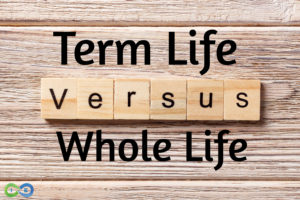Understanding 1035 Exchanges:
How to “trade in” your life insurance, long-term care coverage, or annuity for a plan that better suits your needs
Life insurance, long-term care coverage, and annuities can play a key role in your short- and long-term planning. These financial vehicles can help you to ensure that you and your loved ones are protected, both now and in the future.
But oftentimes, income and protection needs and goals can change – and the tools that you have in your financial plan might have to change along with them in order to serve these objectives better.
Unfortunately, though, making such revisions can often be costly – especially if you have a significant amount of gain in your present insurance policy or annuity contract. This is because if you surrender, or “cash out,” the plan, you will incur gains taxes from the IRS.
The good news is that there are strategies available that can allow you to obtain the more updated insurance and financial tools that you need without having to hand over a portion of the gain to Uncle Sam.
One way to do away with the gains taxes that could be incurred is to transact a 1035 exchange. But while 1035 exchanges can make sense for some investors and retirees, there is a myriad of “rules” that need to be followed – and if they aren’t, you could still find yourself owing a large IOU to the IRS!
Here’s how to avoid these tax-related pitfalls and secure the right insurance and/or annuity for your particular needs.
What is a 1035 Exchange and How Does One Work?
A 1035 exchange is a provision in the Internal Revenue Service (IRS) code that allows for a tax-free transfer of an existing life insurance policy, annuity contract, long-term care insurance product, or endowment for another one that is of “like kind.”
This means that Section 1035 exchanges typically require that the transaction involve the same type of insurance or annuity product. In this case, allowable transactions may include the following:
- Life insurance for life insurance
- Non-qualified annuity for non-qualified annuity
- Life insurance for a non-qualified annuity
- Modified endowment contract (MEC) for modified endowment contract
- Life insurance or non-qualified annuity for traditional, hybrid (life insurance or annuity), or qualified long-term care insurance
According to the IRS, “exchange treatment is appropriate for individuals who have merely exchanged one insurance policy for another that is better suited to their needs and who have not actually recognized gain.”
It is important to note that an IRS 1035 exchange is not the same thing as an IRA rollover. That is because the latter transaction constitutes moving the assets from one qualified retirement plan to another. Rather, 1035 exchanges involve “trading” certain types of insurance or annuity vehicles for another policy or contract that is similar.
Life Insurance Example
As an example of a 1035 exchange for life insurance, if you purchased a universal life insurance policy twenty years ago that provides $1 million in death benefit coverage, along with a cash value component that initially paid an interest rate of 8%, your funds in the policy may have built up at a healthy pace – at least they did in the past.
However, throughout the years – as interest rates in the economy have fallen to much lower levels – the cash value build up in the policy has slowed significantly.
In addition, as you have aged, the mortality cost (i.e., the cost of the death benefit coverage) has increased, due to the higher risk of the insurance company having to pay out a claim to the beneficiary(ies).
Therefore, as you see the amount of the policy’s cash value go down, while the cost of the death benefit coverage rises, you become concerned about having to pay higher (possibly even much higher) premiums down the road. In this instance, a 1035 exchange from your current policy into a new guaranteed universal life insurance plan could make sense for you.
In going this route, you may be able to use the remaining cash value that is in your original universal life insurance policy and put it towards the new policy, in turn, reducing your overall coverage cost, as well as locking into a policy that offers fixed premium rates for the remainder of the contract’s life.
Depending on the particular policy, you may also be able to obtain additional “living benefits” on the new plan. These are benefits that could be used during your lifetime, such as a(n):
- Waiver of premium rider
- Critical illness and/or chronic illness rider(s)
- Disability income rider
- Long-term care rider
While some living benefit riders require an additional amount of premium payment, others are free and are automatically included in the plan. With that in mind, a life insurance 1035 exchange could allow you to significantly enhance the overall coverage that you have, along with postponing gains taxes.
The Many Benefits of 1035 Exchanges
There are several reasons why a 1035 exchange may be beneficial. For instance, unlike simply “cashing out” of a life insurance policy – where there could be tax consequences – a 1035 exchange allows you to “trade” one product for another without concern about paying taxes on gains or “early withdrawals” / surrender of the policy.
Annuites
In addition, it may also be possible to do an annuity 1035 exchange from an outdated and/or underperforming insurance or annuity product to one that offers more updated and attractive features, such as:
- Better investment options
- Higher interest rate
- Less restrictive provisions
Another enticing feature of 1035 exchanges is that they allow you to preserve your original cost basis – even if there are no gains to be deferred. Cost basis refers to the original value of an asset for tax purposes. It is typically determined by taking the purchase price and then adjusting for dividends, stock splits, and/or return of capital (depending on the particular asset).
Capital gains (or losses) are then calculated by taking an asset’s current value and subtracting its original cost basis. With that in mind, if a life insurance or annuity holder cancels or “cashes out” of their current contract, the gains would be taxable. This, however, is not the case if you instead use a 1035 exchange to trade the policy for one that is more suitable, given your current circumstances and needs.
Requirements of a 1035 Exchange Transaction
In order to qualify for a 1035 exchange, the insurance contract and the policy owner have to meet certain requirements. First, it is critical that the currently owned policy or contract is traded for an allowable, or “like kind,” new policy or contract.
Qualifying “Like Kind” 1035 Exchanges
| From: | To: |
|---|---|
| Life insurance | Life insurance |
| Life insurance | Endowment contract |
| Life insurance | Non-qualified annuity |
| Endowment contract | Endowment contract (with a maturity date not later than the original endowment) |
| Endowment contract | Non-qualified annuity |
| Non-qualified annuity | Non-qualified annuity |
Other 1035 exchange requirements include the following:
- The policy or contract owner may not take constructive receipt of the funds (even if the money is used to immediately purchase a new policy or insurance / annuity contract)
- Funds must transfer directly from one policy or contract to the other
- The policy holder, insured, and/or the annuitant must remain the same in both the original policy or contract and the new one
1035 Exchange Options
There are several options for exchanging life insurance, long-term care products, and annuity contracts. For example, both full and partial exchanges are permitted. (Although the specific rules for these types of exchanges can vary from one insurance company to another).
Also, the 1035 exchanges tax treatment can differ for partial 1035 exchange transactions. In this case, only a portion of the policy or contract’s cost basis will be allocated to the new product, as versus all of it.
In addition, a contract or policy owner could transfer part of the value of the exchanged proceeds into a new contract and retain a portion of the proceeds. In this instance, though, any of these proceeds that are taken in cash, as well as funds that are transferred into a non-like-kind contract or used for paying off the balance of a policy loan, are considered to be “boot.”
This means that these funds will then be taxed to the policy holder as ordinary income, to the extent of the gain in the contract, or the amount of the “boot” – whichever of these amounts is less.
As an alternative option, multiple policies or contracts may be exchanged for one single qualifying policy or contract. However, one single contract may not be exchanged for multiple plans.
Is a 1035 Exchange Right for You?
Even though there are numerous benefits to gain by conducting a 1035 exchange, these transactions are not right for everyone. In this case, an exchange must be in the best interest of the policy or contract holder. With that in mind, it is essential to understand both the advantages and potential drawbacks that a 1035 exchange could bring about.
1035 Exchange Pros and Cons
| 1035 Exchange Advantages | 1035 Exchange Drawbacks |
|---|---|
| Can defer taxes on gains | May still have to abide by the surrender charges and/or other fees on the initial policy or contract |
| May obtain better / updated / additional benefits | Cannot take receipt of funds |
| Can transfer initial cost basis | May incur an agent or broker commission on the new policy or contract |
| New policy or contract is more appropriate for your current needs and objectives | Time limit for completing the transaction |
Items to Consider Before You Conduct a 1035 Exchange
Even if a 1035 exchange will benefit you, there are several items that you should consider before moving forward with this type of transaction. For instance, there is usually a time limit associated with how long the exchange takes. In this case, if you wait too long to complete the 1035 exchange, you might face a taxable event.
It is also important to note that an existing insurance policy or annuity should not be cancelled prior to the new plan being issued. This is because it may be possible that the policy or contract holder won’t qualify (based on health or other issues) for the new plan. Therefore, cancelling the old policy or contract could end up leaving you with no coverage at all.
Other considerations should include:
- New suicide and “contestable” provisions on the new policy (i.e.,
- Amount of the new policy or contract’s premium
- New surrender period
- Differences in policy provisions and guarantees
- Different interest rate and/or the way in which interest is credited
- Repayment of any policy loans that were taken from the old plan
In addition, even though 1035 exchanges can provide nice tax-related benefits, these transactions do not absolve the contract or policy owner of their obligations under the original plan.
For instance, if an insurance or annuity contract is still within its surrender period, these charges are not typically waived – even in a 1035 exchange. (Note, however, that if the new policy is from the same insurance company, some or all of these “early withdrawal” fees could be eliminated).
Talking over these items with a life insurance or annuity expert can help you to ensure that you stay on track and complete the process in a timely manner and with all of the necessary paperwork and requirements done.
Alternatives to a 1035 Exchange
If a 1035 exchange is not in your best interest, but your current life, long-term care, or annuity is no longer the best fit for you either, you could still have some possible alternatives available.
These alternatives may include:
- Surrendering the current policy or contract
- Conducting a partial 1035 exchange
- Purchasing an additional policy or plan (and also keeping your current plan in place)
For instance, if there is no gain in your existing policy or contract, and/or if there are no outstanding policy loans that represent a partial gain, a 1035 exchange might not provide you with much benefit. Therefore, surrendering the plan could be a better option. This is particularly true if there is no (or a very low) surrender charge period on your present plan.
Prior to moving forward with a surrender, it is important to consider factors such as the:
- Economic climate
- Financial condition of the current insurance carrier
- Present needs or goals for the policy (and whether or not these are still pressing)
In some instances, a partial 1035 exchange transaction may be the best alternative. With a partial 1035 exchange, you could exchange just a portion of your annuity or insurance policy directly for another annuity or policy, and still qualify for the tax-free treatment.
You need to be careful with these transactions, too, as the IRS deems that “if amounts are withdrawn or surrendered from either contract for a 12-month period of time that starts on the date that the exchange proceeds are received by the recipient company, the partial exchange will be retroactively disqualified, unless the owner qualifies for an exception.”
Depending on your particular objectives, it could make sense to keep your current policy or contract, and to also purchase a new annuity or insurance coverage. Talking over all of your possible options with an insurance specialist is highly recommended before you move forward with any of these alternatives.
Do You Want to Learn More About Exchanging Your Policy for One That Better Suits You?
As your life changes, your financial and insurance needs may also have to be updated in order to better fit with your current circumstances. So, if you have recently gone through a marriage or divorce, loss of a spouse, birth or adoption of a child or grandchild, and/or the purchase or sale of a business, it is possible that your insurance and/or income needs have changed.
While insurance and annuities can be an integral part of your overall financial and retirement plan, though, these vehicles can also contain a number of “moving parts.” Because of that, working with a specialist in this area can help you to narrow down which policies or contract(s) – if any – are the best tools for you.
At Insurance and Estates, our goal is to provide you with the best insurance protection for your circumstances. Whether that is for ensuring financial security for your loved ones, generating an income that lasts for the remainder of your lifetime, or setting up access to tax-free cash, our specialists at Insurance and Estates can help.
We will also work with you to regularly review your plan so that any necessary changes may be made – such as a tax-free 1035 exchange – in order to reflect your current needs and objectives.
So, if you would like to learn more about protecting those who matter most, feel free to give us a call, send an email, or comment below with any questions that you may have and we’ll get in touch. We look forward to assisting you.





